Executive Summary
Welcome to ALLFED’s 2023 Highlights, our annual update on what Alliance to Feed the Earth in Disasters has been up to this year. From advising Open Philanthropy on food security, to sbumitting 6 new papers for peer review, to writing preparedness/response plans for 3 governments, we have made substantial strides towards our mission to increase resilience to global food catastrophes.
There is much more we could do, as we are currently funding constrained. If you like what you read in this post, please see also our 2023 ALLFED Marginal Funding Appeal and consider donating to us via our website this giving season.
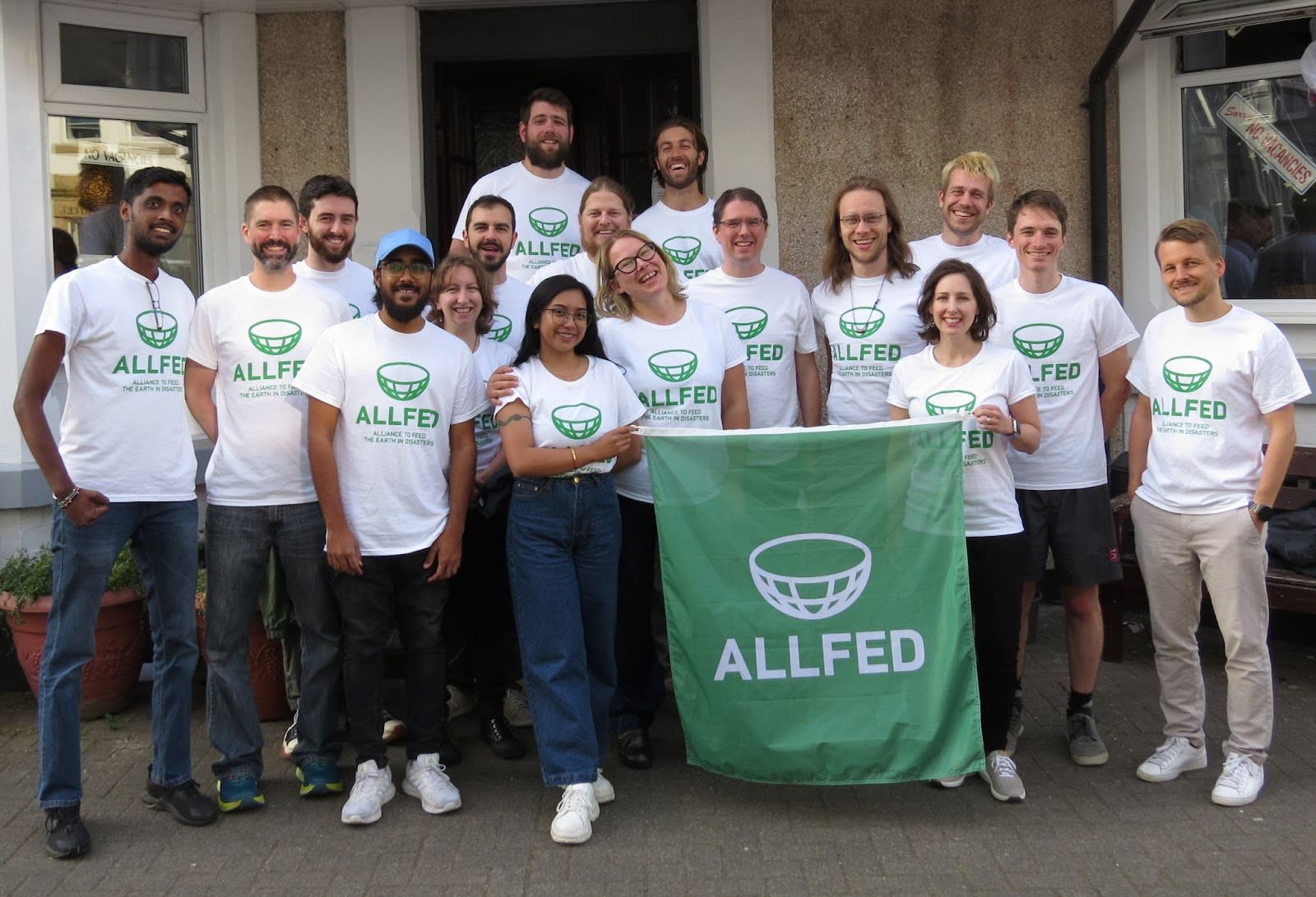
About one third of our fully remote global team (Blackpool, UK).
Increasing geopolitical tensions have presented an opportunity to translate ALLFED’s scientific research into actionable policy proposals with endeavors such as writing national preparedness and response plans against abrupt sunlight reduction scenarios (ASRS, e.g. volcanic or nuclear winter) for various countries such as the United States, Australia, and Argentina.
We continue to explore further options for governments to plan and develop technology through pilots. We have worked towards producing the evidence base needed to inform decision making prior to and during global catastrophe, with 6 new core ALLFED papers submitted for peer review. We have also redoubled efforts in studying responses to potential mass infrastructure collapse scenarios, such as from large scale nuclear electromagnetic pulse, AI-powered cyberattacks, or extreme pandemics (e.g. high transmissibility and mortality causing mass absenteeism). On this topic, we have produced around half a dozen papers over the years (including one this year).
Here is what we you can read about in these 2023 Highlights:
- We kick off with a strategy section and some insights into our top-level thinking and ALLFED’s Theory of Change.
- We then report on our research, including 6 new papers submitted for peer review and some contraptions we have engineered. According to an analysis of the Cambridge Centre for the Study of Existential Risk paper database, ALLFED team members are the second, third, fourteenth, and twenty-first most prolific X-risk academic researchers in the world.
- We talk about our policy work next, focusing on engagements with the governments of Australia and Argentina (through partnership with the Spanish speaking GCR org) as well as the United States policy engagement (which included endorsement of Senator Edward Markey’s Health Impacts of Nuclear War Act).
- We then move to communications, especially our GCR field-building and science communications. It has been gratifying to see ALLFED’s work propagating and an increasing use of our field-defining terminology, which we give examples of here.
- We follow up with events, circa 20 presentations and an account of a recent workshop that we gave at EAGx Australia.
- We then move to operations, the backbone of ALLFED’s day-to-day activities, and an important element of our organizational resilience for response in a GCR (one modality of our Theory of Change).
- Our team section comes next, where we celebrate our team. ALLFED’s multilingual team members are located around the globe and can talk about our work, and deliver workshops and presentations in a number of languages, including Spanish, German, French, Russian, Czech, Polish, Kannada, Tamil, Hindi, Filipino, Yoruba and more. In the team section, we also share with you a fun seaweed-eating experiment some of our team members participated in to experience a 10% seaweed diet.
- We close with thanks and acknowledgements, to all our donors, collaborators and supporters. We would like to take this opportunity to especially thank Greg Colbourn and the Centre for Enabling EA Learning & Research (CEEALAR) for generously supporting ALLFED’s 2023 team retreat. They made an important contribution to our ability to do deep thinking and indeed review ALLFED’s entire Theory of Change by providing us with the physical space in which our fully remote team could get together in person and workshop through our cruxes (see here for CEEALAR’s marginal funding appeal).
You can see ALLFED’s 2022 Highlights here. We hope you enjoy this year’s update.
Strategy
2023 saw us completing a critical Theory of Change (TOC) review, incorporating the lessons we have learned in recent years and the post-COVID 19 changes to the sociopolitical environment.
ALLFED’s TOC seeks to build resilience to global catastrophes through targeted research, communicating with stakeholders and working towards the implementation of effective policy, planning, and investments to build resilience.
ALLFED works with world leading researchers to develop the field of resilient foods and identify novel opportunities to develop new food technologies suitable for ensuring food production during global disasters across the following streams:
- Preparedness. Research has been reviewed, published, distributed, and stored in secure locations. Industry pilots have been conducted.
- Response. National and international response plans have been developed and disseminated.
This may be accomplished through the following modalities:
- Targeted GCR resilience research. Due to the nature of the threat class, transdisciplinary and interdisciplinary research will span engineering, agronomics, economics, and sociology.
- Science communications. This will entail providing accurate, clear and useful information relevant to audiences, summarizing the risks and what can be done.
- Feedback and collaboration. Feedback and collaboration with other groups working on relevant fields will need to be incorporated into research and other efforts.
- Internal resilience, response and capacity-building. The ALLFED team needs to be trained in internal crisis response, able and available to provide expertise in a variety of scenarios, and ALLFED’s research and other resources need to be available and accessible to policy- and decision-makers (e.g. preserving research in protected locations).
Research
Over the last 12 months, while our research team has remained focused on ALLFED’s research priorities, there has been a general shift of a portion of ALLFED’s resources towards policy engagement and advocacy.
Recent research outputs include work on leaf protein concentrate, agricultural residue utilization in Africa, and the intersection of nuclear winter with planetary boundaries. In addition to research addressing ASRSs, we also worked on infrastructure collapse scenarios, such as crop yield loss modeling, supply chain interventions (transportation of food and water) and system dynamics.
We aim to continue to make progress on all three pillars of ALLFED’s work: research, policy, and investigating possibilities for piloting technologies.
In addition to ALLFED’s core research (in this section), you can read more about our science communications here, and personal achievements of our researchers and research recruitment here.
Peer-Reviewed Literature
Seaweed as a Resilient Food Solution After a Nuclear War
Jehn, F.U., Dingal, F.J., Mill, A., Harrison, C., Ilin, E., Roleda, M.Y., James, S.C., and Denkenberger, D. 2023. Seaweed as a Resilient Food Solution After a Nuclear War. Earth’s Future. In Press, preprint available at: http://dx.doi.org/10.5281/zenodo.10118236.
Abrupt sunlight reduction scenarios such as a nuclear winter caused by the burning of cities in a nuclear war, an asteroid/comet impact or an eruption of a large volcano inject large amounts of particles in the atmosphere, which limit sunlight. This could decimate agriculture as it is practiced today. We therefore need resilient food sources for such an event. One promising candidate is seaweed, as it can grow quickly in a wide range of environmental conditions.
To explore the feasibility of seaweed after nuclear war, we simulate the growth of seaweed on a global scale using an empirical model based on Gracilaria tikvahiae forced by nuclear winter climate simulations. We assess how quickly global seaweed production could be scaled to provide a significant fraction of global food demand. We find seaweed can be grown in tropical oceans, even after a near worst case nuclear winter (150 Tg (teragrams or million tons) of soot put into the stratosphere).
The simulated growth is high enough to allow a scale up to an equivalent of 70% of the global human food demand (spread among food, animal feed, and biofuels) in under a year, while only using a small fraction of the global ocean area. The main limiting factor being the speed in which new seaweed farms can be built. The results also show that the growth of seaweed increases with the severity of the nuclear war, as more nutrients become available due to increased vertical mixing. This means that seaweed has the potential to be a viable resilient food source for abrupt sunlight reduction scenarios.
[Note of acknowledgement] The authors would like to thank Scott Carlton James (Baylor University), who has recently passed away, who helped with the initial scoping of the project by running some of the ocean model data through his growth model and providing said growth model to the project. He was a friendly and encouraging person who was quick to assist when questions arose. We appreciate his contributions.
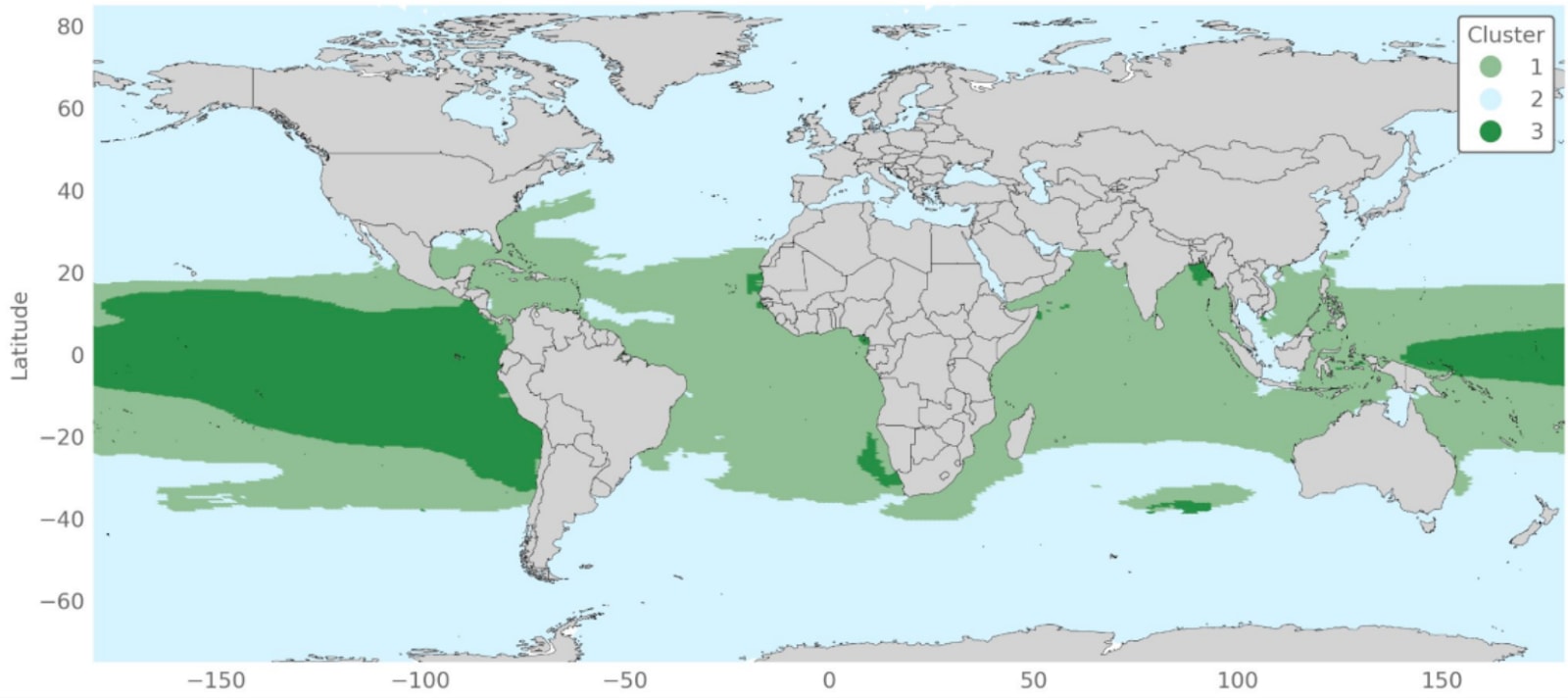
scenario. Colors indicate different clusters (dark green is the best growth, light green is moderate, light blue indicates barely to no growth).
The Fragile State of Industrial Agriculture: Estimating Crop Yield Reductions in a Global Catastrophic Infrastructure Loss Scenario
Moersdorf, J., Rivers, M., Denkenberger, D.C., Lutz, B., and Jehn, F.U. The Fragile State of Industrial Agriculture: Estimating Crop Yield Reductions in a Global Catastrophic Infrastructure Loss Scenario. Global Challenges. (In press). Preprint available at: https://zenodo.org/record/8198966.
Modern civilization is highly dependent on industrial agriculture. Industrial agriculture in turn has become an increasingly complex and globally interconnected system whose historically unprecedented yield relies strongly on external energy inputs in the shape of machinery, fertilizers, and pesticides. This leaves the system vulnerable to disruptions of industrial production and international trade. Several events have the potential to damage electrical infrastructure on a global scale, including electromagnetic pulses caused by solar storms or the detonation of nuclear warheads in the upper atmosphere, a pandemic leading to a significant reluctance to attend their workplaces, as well as a globally coordinated cyber-attack.
The COVID-19 pandemic has highlighted the importance of crisis preparation and the establishment of more resilient systems. To improve preparation for high-stake risk scenarios their impact especially on critical supply systems must be better understood. To advance understanding of the implications for the global food system, this work aims to estimate the effect a global curtailment of industrial production could have on crop yields of the major staple crops: corn, rice, soybean, and wheat. We use a generalized linear model to estimate the loss in crop yield based on temperature, moisture, soil characteristics, nitrogen and pesticide application rates, the fraction of irrigated area and mechanization. The model predicts crop yields in two phases following a global catastrophe which inhibits the usage of any electric services. Phase 1 reflects conditions in the year immediately after the catastrophe, assuming the availability of fertilizer, pesticides, and fuel stocks. However, those stocks would be subject to rationed use in the first year. In phase 2, all stocks are used up and artificial fertilizer, pesticides and fuel are not available anymore. The predictions show a reduction in yield of 15 to 37 % in phase 1 and between 35 to 48 % in phase 2 depending on the crop. Actual drops would be larger because of some loss of improved crop varieties.
Soybean is least affected while wheat, rice and corn decline roughly by the same amount. Overall Europe, North and South America and large parts of India, China and Indonesia are projected to face major yield reductions of up to 95% while most African countries are scarcely affected. The findings clearly indicate hotspot regions which align with the level of industrialization of agriculture and highlight the need for preparation.
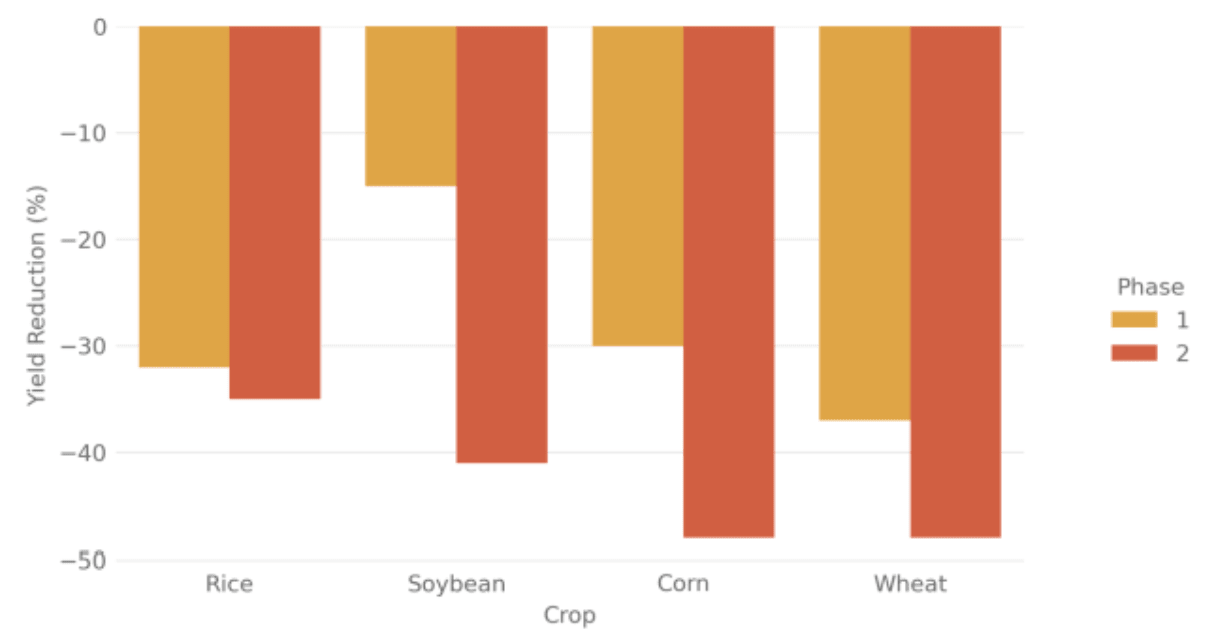
Values are weighted by the production of the cells, which denote area times yield,
as those areas are more important for food security.
Soluciones Alimentarias Resilientes Para Evitar La Hambruna Masiva Durante un Invierno Nuclear en Argentina
Ulloa Ruiz, M.A., Torres Celis, J.A., Rivers, M., Denkenberger, D.C., and García Martínez, J.B. Soluciones Alimentarias Resilientes Para Evitar La Hambruna Masiva Durante un Invierno Nuclear en Argentina. 2023. Revista de Estudios Latinoamericanos sobre Reducción del Riesgo de Desastres (REDER). Forthcoming.
As a network of professionals dedicated to the prevention of global catastrophes, Observatorio de Riesgos Catastróficos Globales chose to examine Argentina in this paper due to its location, agricultural production capacity, and supply chain resilience, among other relevant indicators. These factors augment Argentina’s capacity to respond to an ASRS and to play a crucial role in the distribution and exportation of food. Preparation and response could mean the difference between starvation and production of sufficient, varied, and nutritious food with a surplus to export, preventing a refugee crisis. Read the supplementary report in English or Spanish.
Una guerra nuclear, una erupción volcánica, o el impacto de un asteroide o cometa pueden reducir la cantidad de luz solar que alcanza la superficie terrestre, de la que depende el sistema alimentario global. Los rendimientos agrícolas caerían en picado debido a la bajada de temperaturas y precipitaciones, en lo que se define como un Escenario de Reducción Abrupta de la Luz Solar (ERALS). La región de Argentina puede tener un papel clave en caso de que esto ocurriese. Aquí se presenta y se modeliza un conjunto de intervenciones de respuesta que permitirían prevenir la hambruna en Argentina o incluso América Latina en general, incluyendo: redirección de alimentos usados como materias primas en la agricultura animal y producción de biocombustibles, racionamiento, relocalización de cultivos, despliegue de invernaderos simples y cultivo de algas, entre otras.
Si no se implementasen adaptaciones adecuadas, la producción bruta podría caer al 30% del nivel actual, resultando insuficiente para la población Argentina. Afortunadamente, las adaptaciones propuestas permitirían suficiente producción de alimentos para prevenir la muerte por inanición de la población Argentina, e incluso de varios cientos de millones de personas más. Los resultados indican que incluso en un escenario de 150 Tg las adaptaciones permitirían aumentar la producción neta desde una situación de hambruna nacional (1500 kcal/día/persona) hasta una producción equivalente a entre 3 y 6 veces la cantidad necesaria para la población (7800 - 14000 kcal/día/persona).
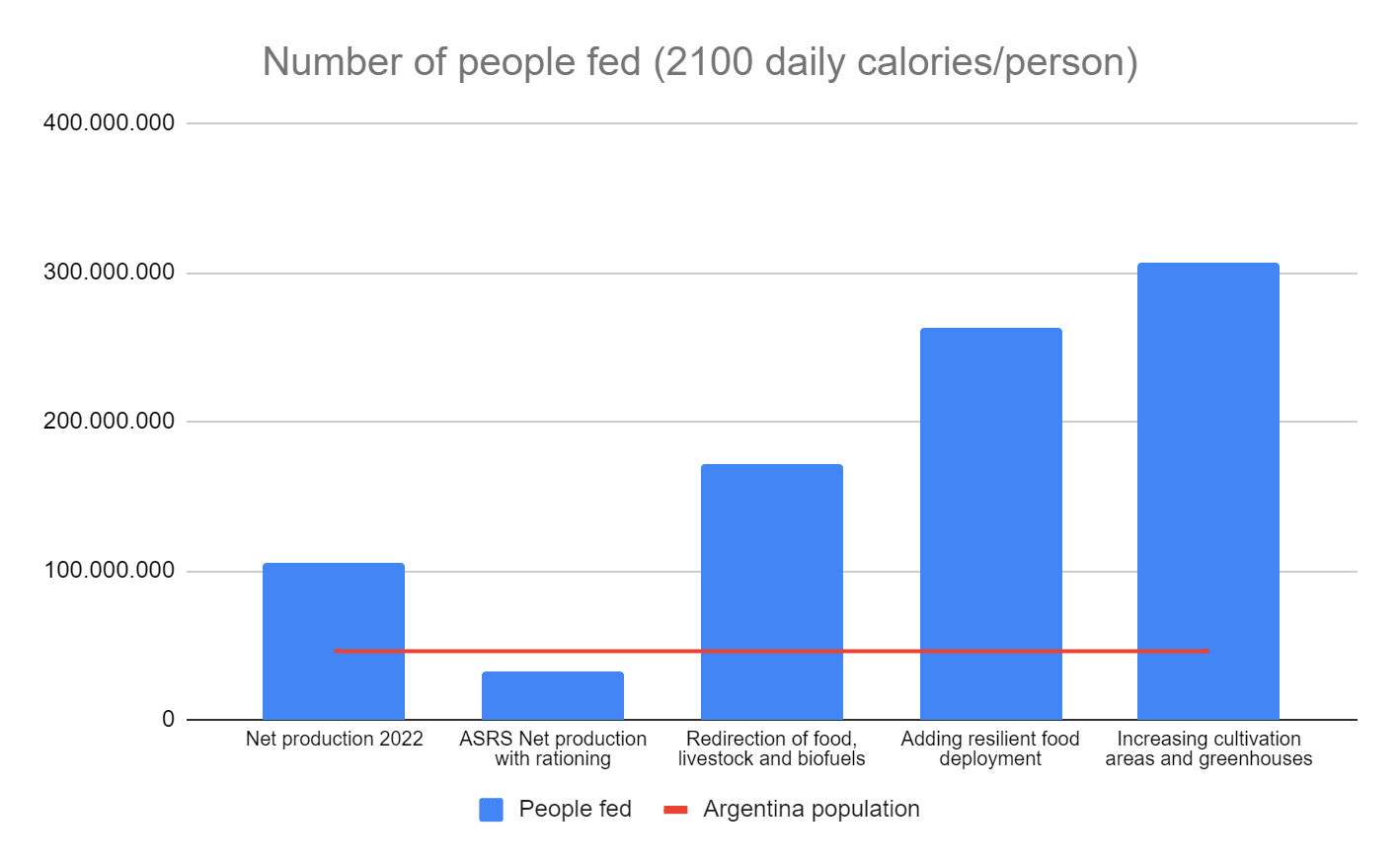
An equivalent requirement of 2100 kcal/day/person is accounted for.
Quantifying Alternative Food Potential of Agricultural Residue in Rural Communities of Sub-Saharan Africa
Ugwoke, B., Tieman, R., Mill, A., Denkenberger, D., and Pearce, J.M. Quantifying Alternative Food Potential of Agricultural Residue in Rural Communities of Sub-Saharan Africa. 2023. Biomass. 3(2):138-162. DOI: https://doi.org/10.3390/biomass3020010.
Some African countries have been severely affected by food insecurity such that 54% of the population (73 million people) are acutely food insecure, in crisis or worse. Recent work has found technical potential for feeding humanity during global catastrophes using leaves as stop-gap alternative foods. To determine the potential for adopting agricultural residue (especially crop leaves) as food in food-insecure areas, this study provides a new methodology to quantify the calories available from agricultural residue as alternative foods at the community scale. A case study is performed on thirteen communities in Nigeria to compare national level values to those available in rural communities. Two residue utilization cases were considered, including a pessimistic and an optimistic case for human-edible calories gained. Here, we show that between 3.0 and 13.8 million Gcal (billion calories) are available in Nigeria per year from harvesting agricultural residue as alternative food. This is enough to feed between 3.9 and 18.1 million people per year, covering from 10 to 48% of Nigeria’s current estimated total food deficit.
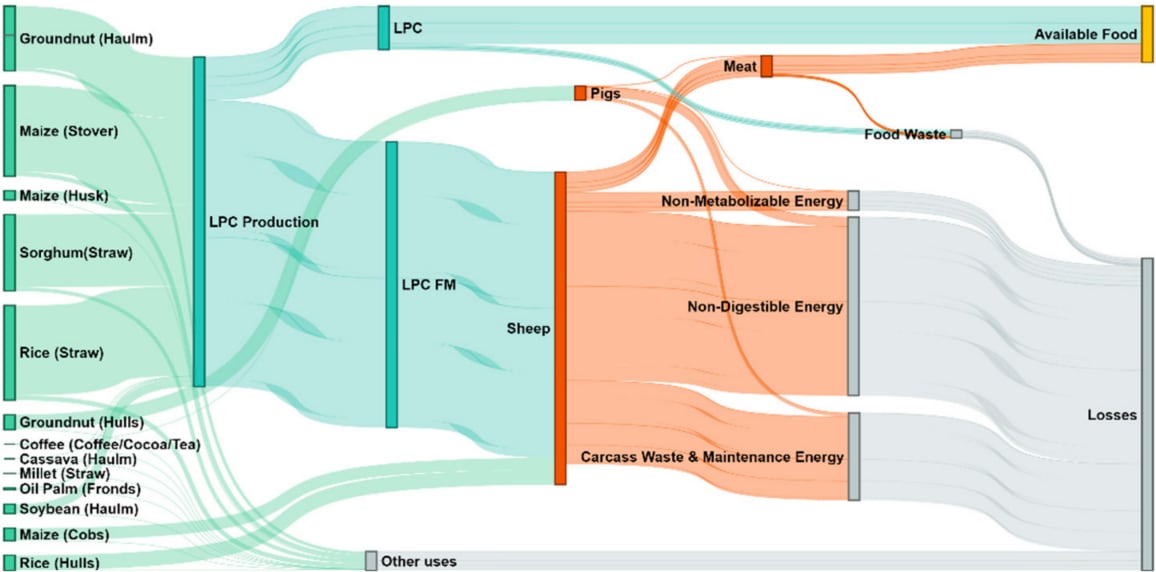
utilization case, assuming optimistic efficiencies.
Yield and Toxin Analysis of Leaf Protein Concentrate from Common North American Coniferous Trees
Mottaghi, M., Meyer, T.K., Tieman, R.J., Denkenberger, D., and Pearce, J.M. Yield and Toxin Analysis of Leaf Protein Concentrate from Common North American Coniferous Trees. 2023. Biomass. 3(2):163-18.7 DOI: https://doi.org/10.3390/biomass3020011.
In the event of an abrupt sunlight reduction scenario, there is a time window that occurs between when food stores would likely run out for many countries (~6 months or less) and ~1 year when resilient foods are scaled up. A promising temporary resilient food is leaf protein concentrate (LPC). Although it is possible to extract LPC from tree biomass (e.g., leaves and needles), neither the yields nor the toxicity of the protein concentrates for humans from the most common tree species has been widely investigated. To help fill this knowledge gap, this study uses high-resolution mass spectrometry and an open-source toolchain for non-targeted screening of toxins on five common North American coniferous species: Western Cedar, Douglas Fir, Ponderosa Pine, Western Hemlock, and Lodgepole Pine. The yields for LPC extraction from the conifers ranged from 1% to 7.5%. The toxicity screenings confirm that these trees may contain toxins that can be consumed in small amounts, and additional studies including measuring the quantity of each toxin are needed. The results indicate that LPC is a promising candidate to be used as resilient food, but future work is needed before LPCs from conifers can be used as a wide-scale human food.
Anthropocene Under Dark Skies: The Compounding Effects of Nuclear Winter and Overstepped Planetary Boundaries
Jehn, F.U., Anthropocene Under Dark Skies: The Compounding Effects of Nuclear Winter and Overstepped Planetary Boundaries. 2023. Intersections, Reinforcements, Cascades: Proceedings of the 2023 Stanford Existential Risks Conference. Available at: https://purl.stanford.edu/zb109mz2513.
The analysis of global catastrophic events often occurs in isolation, simplifying their study. In reality, risks cascade and interact. Therefore, it is essential to consider the interconnected nature of global risks. This investigation explores the interplay between nuclear winter and planetary boundaries. It may seem reasonable to assume that respecting planetary boundaries, which define a safe operating space for the planet, is preferable before a nuclear war. However, that does not always seem to be the case. For instance, increased nitrogen emissions today could serve as a nutrient buffer during nuclear winter. Contrastingly, mitigating climate change, means an even larger temperature drop in nuclear winter in comparison with pre-industrial times. This exploratory study also highlights planetary boundaries that could enhance human survival if we adhere to their limits, both presently and after a nuclear war. The best example being biosphere integrity, as conserving it has no direct downsides and would make the Earth system more resilient to resist the shock of a nuclear winter.
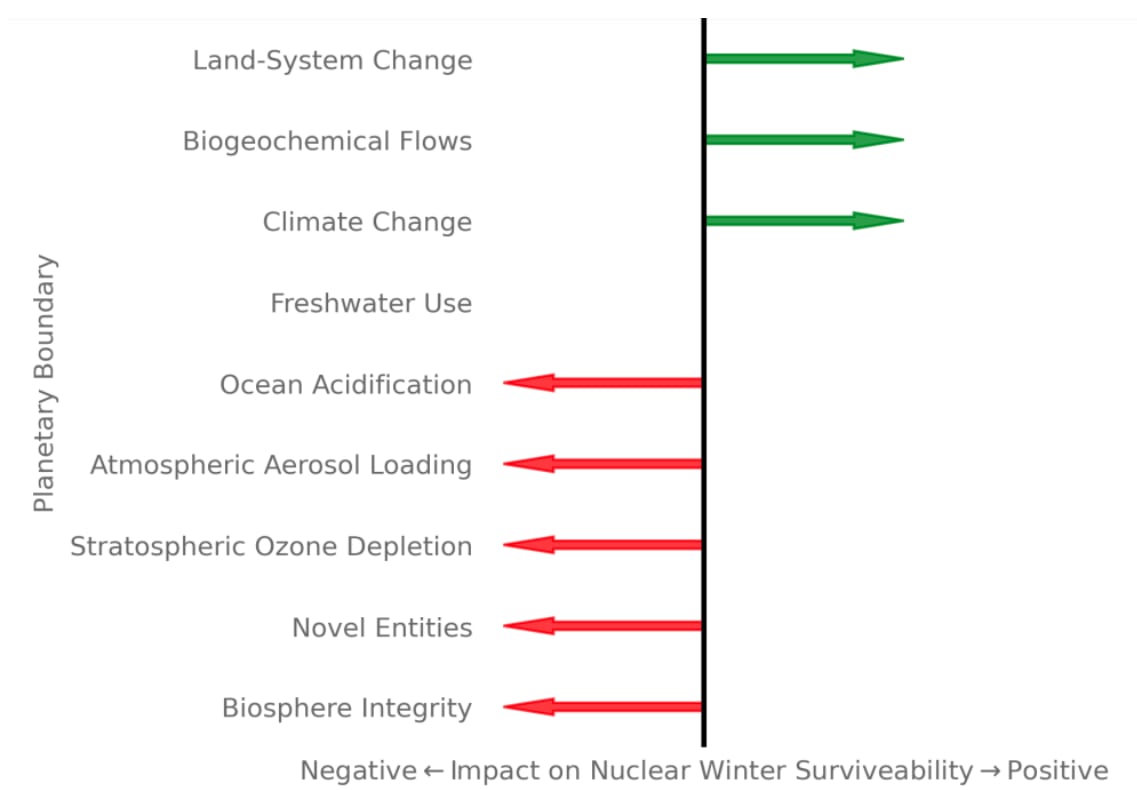
Other Publications
- Akram,H., Masanpally, M., Butt, T.E., and Denkenberger, D.C. 2023. Risk and (Un)Certainty: The Implications of the Relationship.
- García Martínez, J.B. 2023. Repurposing Paper Mills for Food Production. The Australasian Pulp and Paper Technical Association (APPITA). Available at: https://resources.appita.com/resources/member/appita_industry_guide_2022
- Rios Rojas, C., Payne, B., Kuang Heng, Y., Fysh, A., Kane, A., Rickli, Jean-Marc, Fourie, K., Ingram, P., García Martínez, J.B., Cabral, M., and Okechukwu Effoduh, J. 2023. Building a Science-Policy Interface for tackling the Global Governance of Catastrophic and Existential Risks. Centre for the Study of Existential Risk (CSER). Available at: https://www.cser.ac.uk/resources/report-building-science-policy-interface-tackling-global-governance-catastrophic-and-existential-risks/
Other Research
In 2023, ALLFED’s research team has been working on modeling outdoor crop relocation and seaweed deployment in nuclear winter scenarios, two of the most promising food production interventions for this catastrophe.
- Outdoor Crop Relocation. Our team has improved outdoor growing code to make it ~10x faster, more usable and better documented. It is now open source, which you can access here. The team has completed calibration for 6 crops, of which 3 crops have nuclear winter results. For 4 out of 6 of the crops, we are close to the best published correlation between global crop model yields and historical yields.
- Seaweed Deployment. Our research has demonstrated that seaweed will still grow in severe nuclear winter. This means that it can make an important contribution to food security, even in the worst abrupt sunlight reduction scenarios. The growth model is also open source. You can access the growth model here.
In addition, we have conducted research into other aspects of global catastrophic risk (GCR) resilience.
The integrated assessment model of combined resilient food deployment is being revamped and will be updated soon. To date, the team has automated workflows by creating a documentation bot that automatically adds valid and useful documentation to the integrated model. This is critical for future use and uptake of such a model. Thus far it has been applied to a new article looking at country-level nuclear winter response in Argentina.
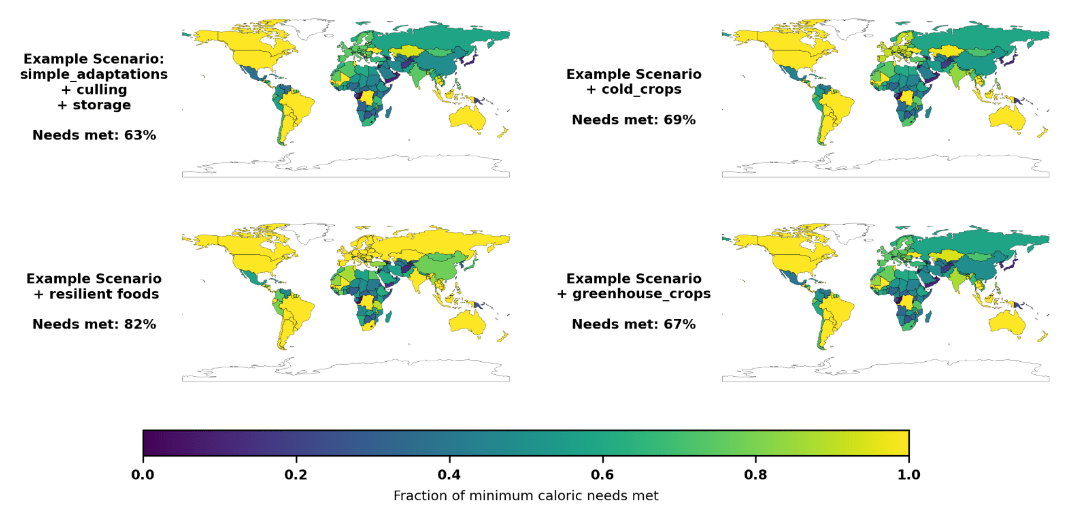
We have made significant progress on resilience to catastrophic electricity loss scenarios, such as extreme pandemics. For instance, we thought that there might need to be a return to animal draft power for farming and transportation, but now we are more optimistic about wood gasification. This involves heating up wood to make a gas that can flow into standard internal combustion engines. This was used extensively in World War II.
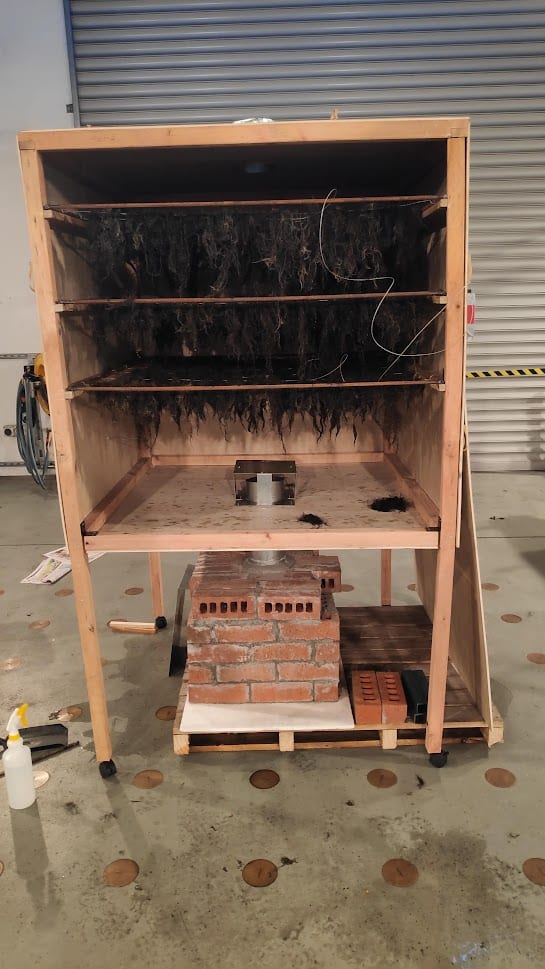 Seaweed racks ready to be dried by fire underneath. | Simon Charman, an undergraduate mechanical engineering student at University of Canterbury, who took an in-person independent course of study under Dr. David Denkenberger, designed a prototype wood fired seaweed dryer. Dr. Denkenberger and Simon prioritized a design that could be scaled up without much infrastructure. They tested the prototype on the seaweed species, Gracilaria chilensis. |
Henry Vennard, an intern, designed a prototype of a wood chipper for biofuel production in a catastrophic electricity loss scenario. This prototype was successful and will inform our work on scaling up wood chipping for gasification to replace diesel and gasoline or petrol in loss of electricity and loss of industry scenarios.

Policy Engagement
We think policy is essential to increase humanity’s resilience against a potential global catastrophic food failure (GCFF). Increasing geopolitical tensions have presented an opportunity to translate our scientific research into actionable policy. Policy could also result in funding for research and pilots. ALLFED has allocated an increased amount of our resources to policy engagement this year. This work stream has included delivery of knowledge products and policy proposals to governments in multiple jurisdictions.
To inform our strategic approach and ensure consistent mission-alignment across our policy engagements, we developed our first Policy component of our Theory of Change (TOC).
The iterative nature of this policy TOC component is key to strategic alliance-building, knowledge-sharing and influencing, and momentum building of global catastrophic food failure (GCFF) resilience policy globally. An important aspect is the push-pull dynamic to and from ALLFED’s research – change-makers across our network shape and are shaped by our research strategy. ALLFED also considers the role of countries in influencing each other to take up new resilience policies, allowing us to build credibility as well as topical momentum as a global organization.
We aim to continue translating our research to policies that increase extreme food resilience through fruitful collaborations in various regions across the world – from Australia to the United States and Argentina. Among other things, we participated in the following fora this year:
- We were invited to the World Food Forum organized by the Food and Agricultural Organization (FAO) of the United Nations. We networked with multiple government officials and other multilateral stakeholders, including the FAO leadership, and high-level members of country delegations.
- We were invited to a number of Chatham House exclusive events, presenting at a closed-doors session earlier in the year, where influential multilateral stakeholders were present. We continue building upon these relationships through continued engagement.
- Our Norwegian policy engagement has led to team members presenting key ALLFED research to the country’s emergency management agency, Directorate for Civil Protection and Emergency Planning. Further engagement with the government is ongoing.
- Florian Ulrich Jehn and Juan B. García Martínez joined the New European Voices on Existential Risk (NEVER) of the European Leadership Network (ELN). NEVER aims to bring together early career researchers and policy makers to build professional networks and exchange ideas about existential risk and how they might be mitigated.
United States Policy Engagement
The Global Catastrophic Risk Management Act (GCRMA) was successfully passed into U.S. law last year (via the National Defence Authorisation Act), and is a world-first for legislation focused on resilience to GCRs. This is highly significant for all GCR-focused organizations. ALLFED was inspired by this success and has sought to build on it through targeted policy engagement in the United States.
This has included collaboration with two congressional offices to bring abrupt sunlight reduction scenarios (ASRS) and health policy proposals to two different United States Congressional Committees. We provided input on the draft legislative text for the Farm Bill, including research priorities and governance developments needed to manage food system risks from ASRS. This was part of direct collaboration on policy formulation with a Senator's office. Our approach to the Farm Bill, and strategic engagements, was informed by networking and direct consultation with various relevant stakeholders (political and non-political) in Washington DC. Our political outreach process included a balance of Democrat and Republican offices.
In addition, ALLFED publicly endorsed a Bill from Senator Edward Markey’s Office (Massachusetts) after working to develop the final version of the Bill through expert advice.
Argentina Policy Engagement
ALLFED has recently partnered with the Spanish-speaking GCR science-policy organization Observatorio de Riesgos Catastróficos Globales to create a landmark report on how to shield Argentina against the most extreme global food catastrophes, involving the loss of sunlight collapsing agriculture globally (e.g. volcanic or nuclear winter). You can watch the online presentations (English, Spanish) and check out the slick infographics they have created to communicate the results (English, Spanish).
The report marks the beginning of our collaboration with the Argentinian government, and it has received support from Argentinian government officials, in particular the Secretary of Federal Articulation of the National Ministry of Security, Silvia La Ruffa, who wrote the foreword. We are collaborating with them to incorporate ASRS in the Argentina National Plan for Disaster Risk Reduction. We hope to continue this partnership in the years to come and help make Argentina a fine example of country-level preparedness against a global catastrophic food failure (GCFF).
As part of ALLFED's engagement strategy, in collaboration with ORCGs, to date this work in Argentina has led to technical conversations with Instituto Nacional de Tecnología Industrial (INTI) and Instituto Nacional de Tecnología Industrial (INTA). The report contains 8 main recommendations, divided into communication and food supply, and food production and redirection in the event of an ASRS, including redirection of feed for livestock and biofuel, adoption of cold and drought tolerant crops, construction of greenhouses, and increase of cultivated areas. As priority actions for effective implementation, we recommend the creation of government contingency plans and the creation of an interdepartmental task force to address the risk.
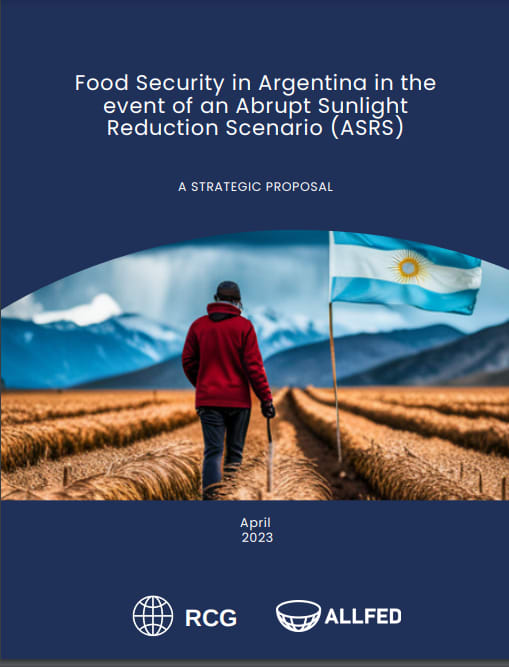 | Food Security in Argentina in the event of an Abrupt Sunlight Reduction Scenario (ASRS) Report. Here is an EA Forum post about it. |
Australian Government Engagement
Through advocacy by Good Ancestors Project founder and ALLFED Australia board member Greg Sadler, the Australian Government recognized catastrophic risks including supervolcanic eruptions and solar storms in their new $200 million per year Disaster Ready Fund (DRF). This annual program aims to build resilience against disasters that could impact global food supplies. Greg's work in Canberra secured meetings with key government stakeholders responsible for national emergency response, including nuclear scenarios.
The ALLFED research team authored the report entitled Australia Abrupt Sunlight Reduction Scenario (ASRS) Response Plan, offering strategies to maintain food security after a catastrophic sunlight disruption. As part of a focused engagement strategy with public servants rather than elected officials, we traveled to Canberra to present these recommendations directly to government teams managing such scenarios. Early indications suggest this may be a successful approach - we secured high-level meetings with relative ease. This work is particularly valuable for ALLFED’s mission, as Australia is uniquely positioned to not only survive but also potentially increase regional food production and feed the Asia Pacific in a nuclear winter (Boyd & Wilson, 2023). We are now confident that in the event of a nuclear winter, the Australian government will have access to our response plan.
ALLFED Australia pursued Disaster Ready Fund (DRF) proposals, meeting with state emergency agencies and a major paper company about cellulosic sugar production. We also scoped potential single cell protein (SCP) pilots with an SCP company and an energy provider. Given the Fund's scope, we pivoted to focus on building government capacity. Our proposal made it as far as the final selection round, and it was recommended that we apply for the next one. Other takeaways from this endeavor included securing support, gaining valuable insights, and connecting with potential future collaborators.
Additionally, ALLFED Australia made multiple submissions responding to parliamentary calls advocating for crisis readiness policies that support global food security.
Moving forward, we aim to continue collaborating with key government departments, industry, academia, and other aligned organizations as well as pursue new opportunities including the second round of Disaster Ready Fund (DRF).
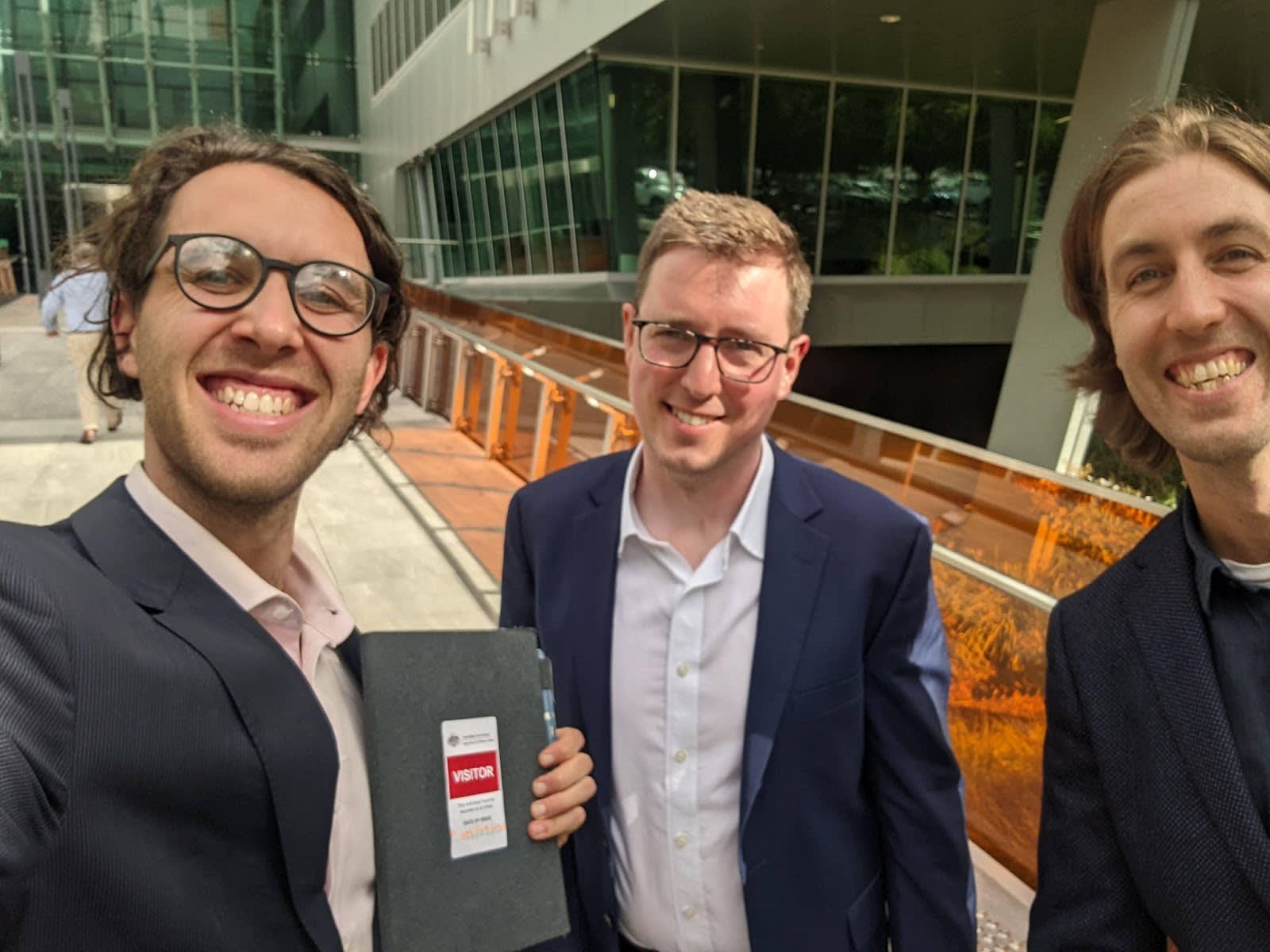
Communications
The majority of ALLFED’s communications work this year has focused on working out how to best communicate our research and GCRs to governments, policy makers and the other key stakeholders. In this, we have made substantial strides.
Additionally, in 2023, we have developed several distinct communications workstreams, boosted our crisis communications capabilities (more on this in the Operations section below) as well as maintained our usual level of media engagement.
GCR Communications
Quite early on in ALLFED’s life, we became aware of the unique challenges we were going to face communicating our work to external stakeholders. And yet, where once we would have encountered blank looks, over 2022-2023 we have seen attitudes to our work change somewhat. The work that once would likely have resulted in much disbelief, or worse, prompt dismissal is now sitting on the desks of decision makers and is being considered for inclusion in government-level planning.
We attribute some of this to the impact of COVID-19 and the Ukraine crisis, which were generally eye-openers. Some of this we attribute to the fields of global catastrophic and existential risks becoming more prominent.
Field-Defining Terminology
An “Abrupt Sunlight Reduction Scenario (ASRS)” is one such term, which was originally used in the “Nutrition in Abrupt Sunlight Reduction Scenarios: Envisioning Feasible Balanced Diets on Resilient Foods” paper, published on 23 January 2022.
As of the time of writing, the term has been used in derivative academic work and the media. As of 2023, it has made its way to government offices. Please see below for one recent example, from an official of the Argentinian government.
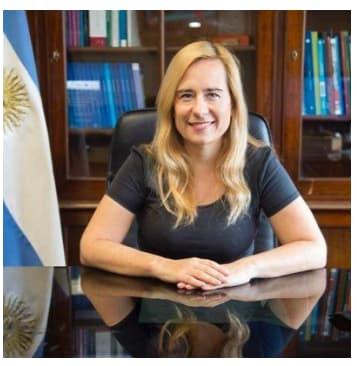 |
|
Field-Building Efforts
In 2019, Open Philanthropy stated that their “interest in emergency foods first came from encountering the work of David Denkenberger and his colleagues at the Alliance to Feed the Earth in Disasters.” This is just one example of ALLFED’s growing recognition as some of the pioneers in the field of resilient foods.
This year, we have continued our awareness-building efforts both on the organizational level and through personal efforts of our team, such as:
- Jaime Sevilla and ALLFED’s Juan B. García Martínez co-founded the Spanish-speaking GCR science-policy organization Observatorio de Riesgos Catastróficos Globales, with the mission of reducing global catastrophic risk through the implementation of public policies in Spanish-speaking countries (which led in the strategic engagement with the government of Argentina, above).
- Florian Ulrich Jehn started Existential Crunch, a living literature review about societal collapse and aims to create a constantly updated overview of literature related to societal collapse. This has a high overlap with ALLFED’s work, as famine has been an important contributor to past societal collapse. Read more here.
- Michael Hinge started Climbing Inari, a blog to collect past writings and interviews. These include articles on threats from Complexity in the Food System and Primer on Nuclear Winter.
Science Communications
Effective science communication is also not only vital for disseminating our research but also for inspiring action and fostering informed decision-making.
Some of our science-specific communications endeavors included:
- A new Science Communication Working Group of ALLFED’s researchers and external collaborators. Our first project had several volunteers creating accessible summaries of our work.
- Continuing the CRASSH (Catastrophic Risk And Social Science and Humanities) Working Group, we aim to further explore the relationships between Global Catastrophic Food Failure (GCFF) and the ways in which it influences and is influenced by the broader societal, economic, and cultural contexts in which it operates.
- We have put a fun twist into our science communications with conversation-starting workshop materials. Check out these new ALLFED pencils which read: “This pencil is made from CD cases. One can make food from plastic, too.” Do feel free to ask if you are curious about the scientific basis for this. :)

ALLFED in the Media
Finally, as one example of our media collaborations this year, here is the “What to Eat in a Global Catastrophe” video feature by Insights for Impact, which we consider a fine introduction to our work.
| Insights for Impact look at “What to Eat in a Global Catastrophe.”
What are major threats to our food supply and the most promising ways to feed the world cheaply, quickly and nutritiously? Resilient food solutions that are scalable and affordable are crucial to increase the chance that we can feed everyone in a catastrophe. This 20 minute video describes ALLFED’s mission, and what our team is doing.
May 2023 |
We especially welcome non-English media coverage. If you could help with some, we would love to hear from you at media@allfed.info.
Events, Workshops & Presentations
Events Attended
2023 saw ALLFED immersing itself in a wide array of events presenting and contributing to significant conversations. From a Pluralisms in Existential Risk Studies workshop to 10 EA Global and EAGx conferences and participating in 16 other conferences, our involvement underscores the pivotal role of knowledge exchange and collaboration.
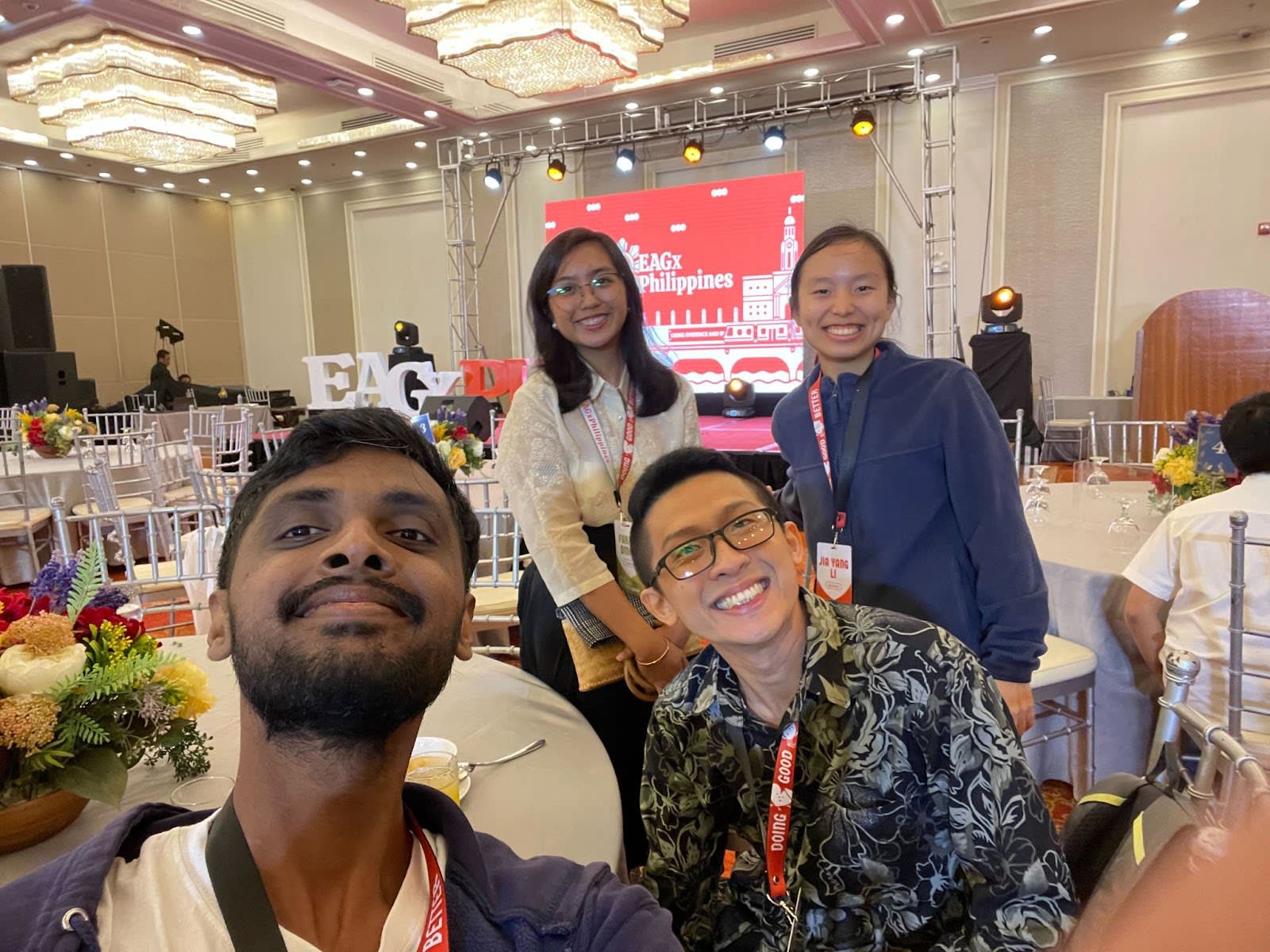
Presentations
In 2023, the ALLFED team presented at numerous global fora, covering a spectrum of topics directly aligned with ALLFED's work. From discussions on existential risks to inclusive futures, the team demonstrated a diverse engagement with audiences worldwide.
Here is the list of presentations by ALLFED in the year 2023;
- EAGxLatinAmerica (6-8 January 2023)
- EA Colorado (25 January 2023)
- EA Wellington (9 February 2023)
- New Zealand Catastrophe Resilience Workshop (9 February 2023)
- Local presentation at Czech University of Life Sciences Prague (23 February 2023)
- Local presentation at Palacký University Olomouc (1 March 2023)
- Local presentation at University of Chemistry and Technology, Prague (7 March 2023)
- EAGx Cambridge (17-19 March 2023)
- Talakayang Alay sa Bayan (TALAB) What's Next? Building Inclusive Futures (Ateneo de Manila University) (21 March 2023)
- European Geosciences Union Conference (EGU) (23-28 April 2023)
- Third Annual Stanford Existential Risks Conference (20-22 April 2023)
- FOODSCAPES: Spain's Pavilion for the Venice Architecture Biennale 2023 (21 May 2023 to 26 November 2023)
- VI International Congress on Risks at the University of Coimbra, Portugal (23-26 May 2023)
- EAGx Warsaw 2023 ( 9-11 June 2023)
- Käte Hamburger Centre for Apocalyptic and Post-Apocalyptic Studies (13 June 2023)
- EAGx Berlin (9 September 2023)
- German Geography Congress Frankfurt (19-23 September 2023)
- EAGx Philippines (20 – 22 October 2023)
- EAGx Australia (22-24 September 2023)
- Sao Paulo 1st GCR conference (26 October 2023)
ALLFED EAGx Australia Workshop
ALLFED x The Long Game Project: Before the Rising Sun Desktop Exercise at Effective Altruism Global x Australia in Melbourne
In partnership with The Long Game Project (LGP), we organized a desktop exercise, Before the Rising Sun, in EAGxAustralia. Attendees include 50 individuals from academia, public service, the legal profession, and various non-governmental organizations (NGOs).
The exercise simulated a global reduction in sunlight, resulting in a food security crisis as well as complex and cascading impacts on aviation, supply chains, and humanitarian movements.
Participants roleplayed as Australian policymakers, corporate moguls, and citizen groups to discuss policy and program pathways that address the short-, medium-, and long-term impacts of a level 8 volcanic explosivity index (VEI) eruption. An explosion of this magnitude is equivalent to a 31 Wm−2 decrease in radiative forcing, that is, a 16 Teragram (Tg) nuclear war scenario.
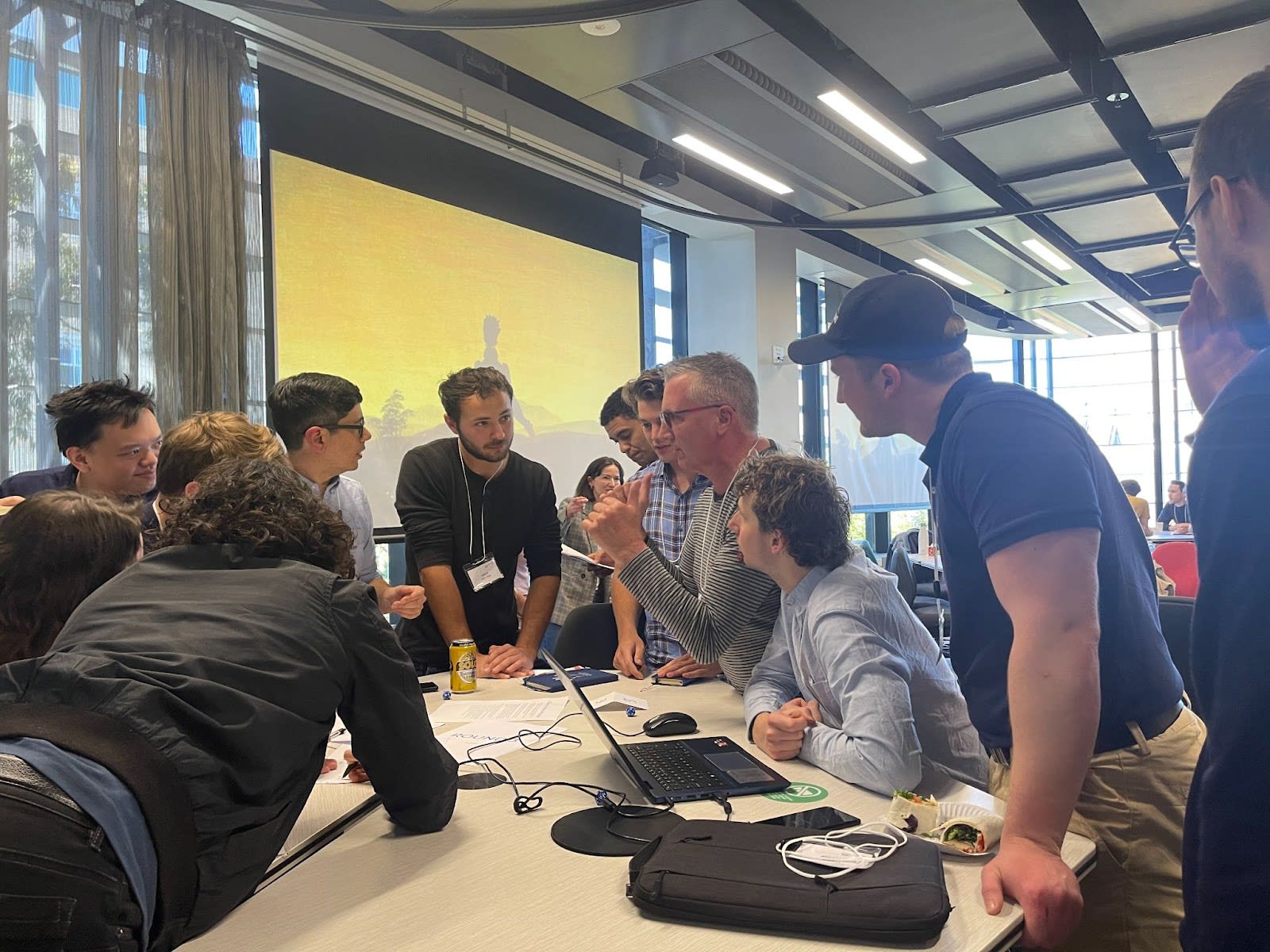
Operations
2023 has been an extremely busy year for ALLFED’s operations team. There are now 2 ALLFED charitable entities, ops resilience and response-related work has been embedded into ALLFED’s top-level Theory of Change, and our organizational capacity has been significantly boosted by numerous improvements across all areas of operations.
ALLFED’s 2 Charitable Entities
There have been a number of key developments from the organizational structure perspective, most importantly, our first full year of operating as an independent 501(c)(3) charity in the USA as well as successfully securing charity status in the UK (see here for more information on how both charitable entities compare).
Internal Resilience, Response, and Capacity-Building
ALLFED’s operations team have been gratified to see “internal resilience, response, and capacity-building” formally incorporated into ALLFED’s Theory of Change this year, as one of the key modalities through which to affect change in the pursuance of ALLFED’s mission.
We have actively pursued this for some time as per the March 2022 post by Sonia Cassidy, ALLFED’s Director of Operations (and also Director of Communications), which featured a case study of ALLFED’s organizational response to the Russian invasion of Ukraine (it also tackled broader matters of resilience of the EA community as such). In 2023, we further boosted ALLFED’s organizational resilience to help towards the actual availability of our team in the event of a catastrophe so that we remain contactable and able to share our research with the world. This varied from more robust crisis communications cascades to looking into the resilience of our website and other key informational infrastructure.
Process and Systems Improvements
We have revised most of ALLFED’s underlying processes and systems across all areas of operations. From IT security to financial compliance to programs/fundraising/overhead ratios, we have looked at what it is that we can do to further improve our organizational efficiency and effectiveness. Some of the key areas of such work we have featured below.
OKRs and KPIs
We have designed our organizational Objectives and Key Results (OKRs) to dovetail into individual Key Performance Indicators (KPIs). This has enhanced alignment across different teams, improving transparency in progress tracking and fostering a culture of transparency accountability.
Project Coordination Framework
To facilitate knowledge management and organizational learning we have experimented with the Triple Loop Learning Framework into our Project Management Frameworks. This allows us to not only to identify areas for organizational improvement but also to identify opportunities for individual growth.
CRM Implementation
In 2023, we have continued a key CRM system implementation (started last year) further improving how we collect, store and manage ALLFED’s connections and relationship data. Here are some examples that may be of interest:
- Crisis communications cascades, relevant to the aforementioned ALLFED’s response and resilience (whereby any team member can be put through at any time to a senior member of ALLFED’s communications and/or management team).
- HR workflows and automations (whereby much training, compliance and contracts-related work has been lifted off the shoulders of our HR coordinator and is now done by the CRM system).
- Improvements to recruitment, and specifically further locking down blind recruitment protocols (whereby personal data of applicants interested in working with us is now kept entirely separate in the CRM system while the content relevant to their actual application or the performance of any work tasks are the only elements that our recruiters receive for their review).
GDPR and Data Management
In our digital age, data management is important to any organization and mission-critical to a fully remote one. To this end, we engage in data compliance and management work on an ongoing basis, with all team members regularly receiving training on new developments and participating in keeping our data in good order.
One significant development on this front has been adoption of the European GDPR personal data standard across the entirety of ALLFED’s operations. Although the global privacy regulation landscape is currently in flux, it is generally accepted that the European General Data Protection Regulation (GDPR) law is at this time the most extensive legal provision for the protection of personal data. While it normally applies to the protection of EU citizens, we have adopted it globally at ALLFED to simplify data transfers across jurisdictions.
Our Team
We love it that we have team members on every continent except Antarctica (we feel we have by now nailed working across time zones and have, in fact, sometimes turned this to our advantage). We love the various cultural backgrounds we now have on our team (we would very much like to encourage more diversity still). And we love that when we do get together, people who may have never before met in person do indeed feel like we are one team.

We had representation from 4 continents.
Team Achievements
As for this year’s team achievements:
- The Board of Advisors for the ALLFED Alliance now has 17 board members located around the globe, and you can read more about them at: https://allfed.info/about/team-and-board
- In recent recruitment rounds, we were able to attract and efficiently process >500 applications for our various positions. We have expanded the research team: 3 job offers accepted (out of 3 offered), 2 paid internships accepted (out of 2 offered), and 1 unpaid internship accepted (out of 1 offered)!
- We have continued our volunteer and internship programs.
- We have dived deeper into the skills and talents of our team, and now keep easily searchable records of core skills such as languages spoken (as per the Executive Summary, please feel free to contact us to see if we can talk about our work in your language) or first aid training (useful for ALLFED’s response team or retreats).
- We have boosted internal capacity and developed team members by providing internal and external training (from interviewing to media training to conflict handling, which we consider important for our team’s mental and emotional resilience, which is in our view important for a GCR organization with catastrophe response on the list of its activities).
- Juan B. García Martínez was a finalist for the Impactful Young Researcher Prize by the Institution of Chemical Engineers. He also co-founded the Observatorio de Riesgos Catastróficos Globales, a GCR science-policy organization. If you would like to know more about his work, read his interview with Amber Dawn on Tackling Many Causes at Once and His Journey into EA.
- Ross John Tieman and Ana Luisa Lopes Monteiro recently began pursuing their PhDs in the Australian National University (ANU) and University of Canterbury (UC), respectively. Also, Farrah Jasmine Dingal graduated from her master’s in Renewable Energy and Sustainability Systems from the Pennsylvania State University (PSU).
- Aron Mill has been able to explore creative ways of communicating Global Catastrophic Risks in his own time for example through an immersive art experience at EAGxBerlin. He is excited about the prospect of merging ALLFED work with different perspectives and approaches to reach a wider audience and make ALLFED solutions more salient.
2023 Team Retreat
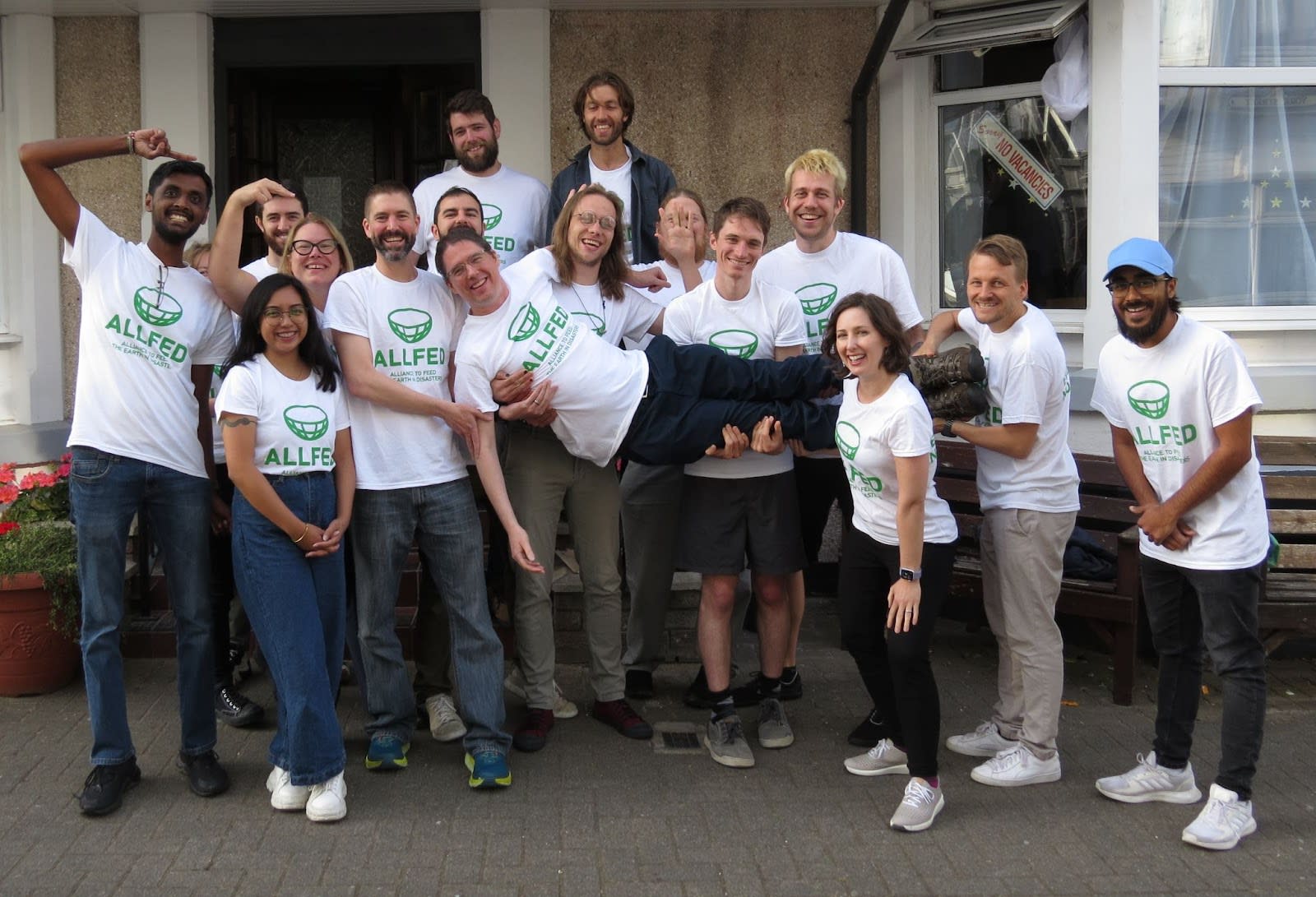
In May 2023, a good chunk of our team (17 team members!) came together from 9 different countries at our 2023 team retreat, which took place in Blackpool. We are grateful to the Centre for Enabling EA Learning and Research (CEEALAR) and Greg Colbourn for providing us with a home away from home and a perfect space in which to hold an intensive and productive deep dive into ALLFED’s core work.
We had a homemade three-course “resilient food dinner”, containing only foods and ingredients that are resilient to a nuclear winter scenario. You can read about it in this article by the chef Isabel Johnson in The Restaurant at the End of the World. On a different day, there was a team-wide official tasting of ALLFED’s first vegan food product prototype designed to provide a bounty of essential nutrients that can be produced from resilient foods.
Some team members embarked on an unconventional journey with a 24-hour seaweed eating experiment, a test of taste buds, tenacity and the strength of their stomach. Through this exercise, they aimed to better understand the practicality and implications of relying heavily on seaweed, particularly nori (Pyropia yezoensis) and wakame (Undaria pinnatifida), as a food source. The participating team members ate and drank a set quantity of seaweed in various forms – as soup, sushi, and salad to a protein shake! | 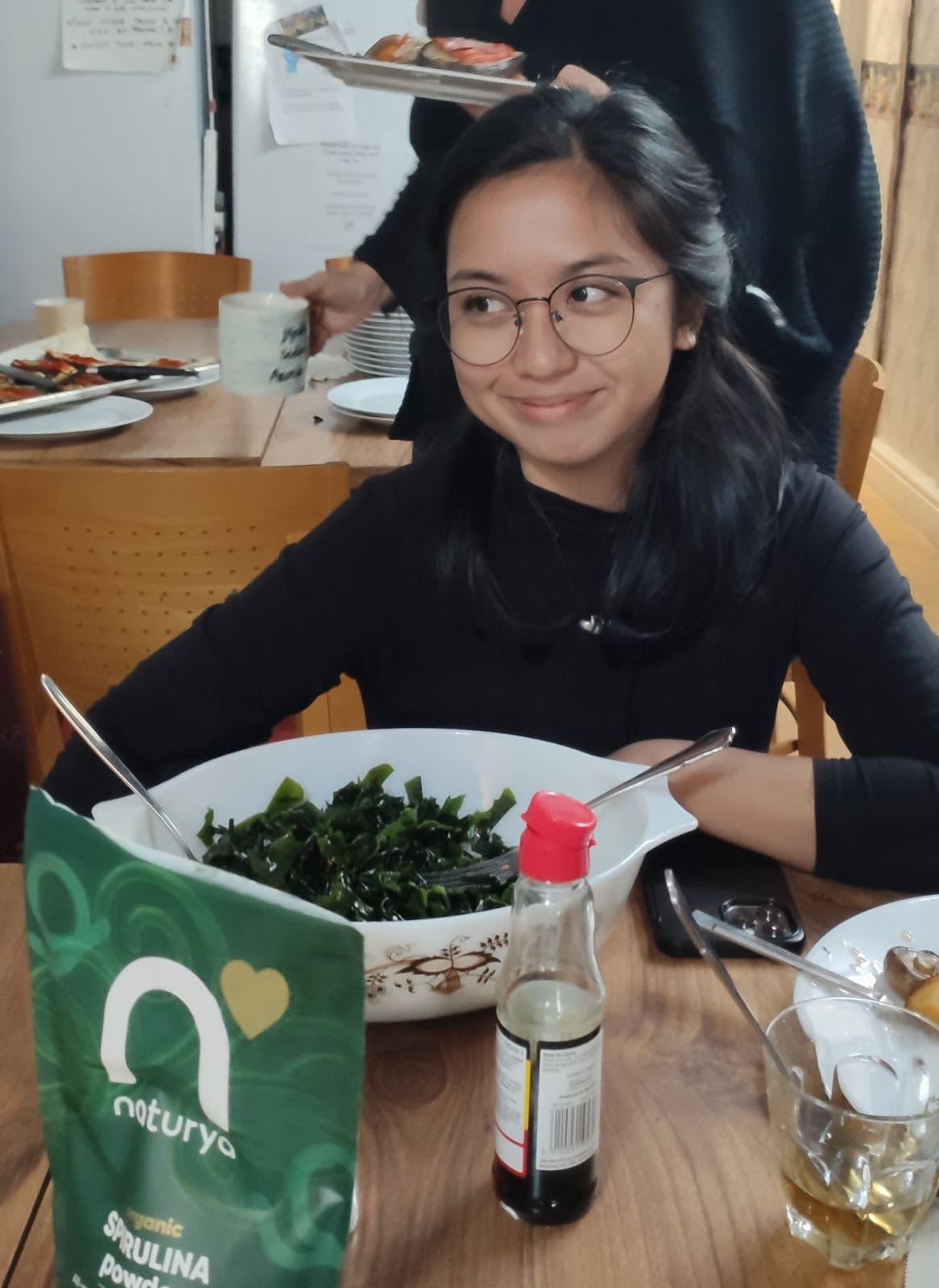 |
Oppenheimer Movie Showing + ALLFED Q&A
ALLFED’s Berlin-based team members organized an ALLFED Q&A session, followed by another Resilient Food Dinner, a meal based on foods that according to ALLFED’s research could still be grown even in a nuclear winter. This included recipes filled with seaweed, potatoes, and sugar (which could come from cellulose), among others. A great write-up of a previous resilient food dinner with recipes can be found here.
Together with the 20 people in the audience and equipped with some nuclear winter trivia, everyone went into the movie release of Oppenheimer afterwards.
Funding Needs
Our room for more funding is large; please see our Marginal Funding Appeal. In particular, we have several highly qualified researchers as temporary positions who we could keep on with additional funding.
Thanks & Acknowledgements
We thank our supporters, donors, team, volunteers, and collaborators, in particular:
- Latham & Watkins for their expert legal advice;
- Jenna Luvjoywel and Christian Pearson from Insights for Impact for the interest they took in our work, and their enthusiasm and effort to really understand it;
- All our volunteers and in particular the volunteers who have written research summaries, including Kate Prebble, Lenny Lai, Luke Dunne, Nathaniel Beardsley, Olga Kuznetsova, and Nayanika Kundu as well as Anuskhka Shah.



Executive summary: ALLFED made major strides towards increasing resilience to global food catastrophes through research, policy engagement, communications, and operations. They submitted 6 papers, advised 3 governments, gave 20+ presentations, and doubled their staff.
Key points:
This comment was auto-generated by the EA Forum Team. Feel free to point out issues with this summary by replying to the comment, and contact us if you have feedback.
This is a decent summary, but there are a couple corrections:
ALLFED increased paid team members, but much less than doubled (we have capacity to expand more quickly with additional funding).
We do have 17 advisory board members, but they represent 4 countries, not 9 (the 9 countries were represented by the 17 team members at the retreat).
Nice! Perhaps when you say Cambridge Centre for Existential Risk you mean the Centre for the Study of Existential Risk? Could you link to their database you mention - I couldn't find it on a quick search.
Thanks for the correction! I have fixed it and added a link (the link was in the main document, but it's good to have it in the executive summary as well).
THanks!